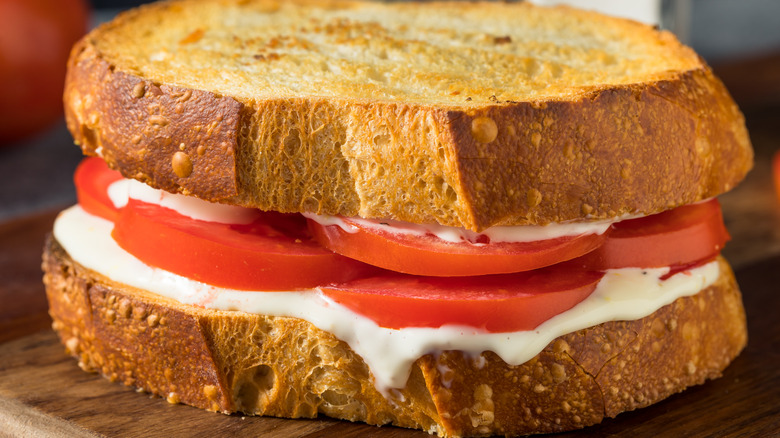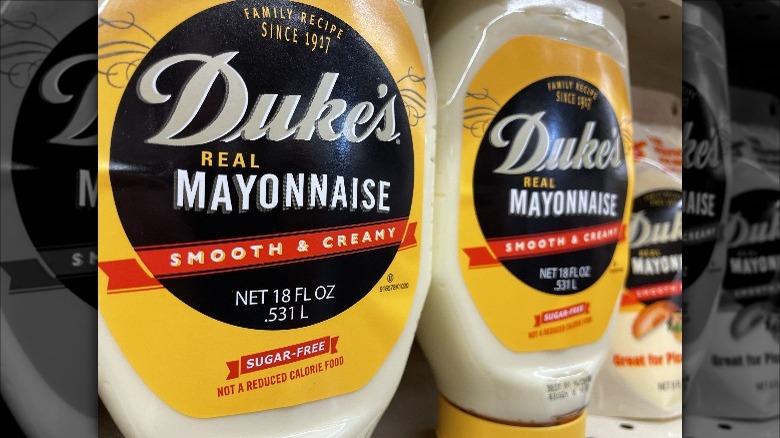The Greenville Mayo Trail In South Carolina Is A Must-See Destination
We may receive a commission on purchases made from links.
If you ever find yourself carousing grocery store aisles with a person of Southern extraction, outside their normal stomping grounds, you're bound to hear them pine over a few things: Southern-style sweet tea (strongly brewed, strongly sweetened), soft buttermilk biscuits, and Duke's mayonnaise. While mayo inspires revulsion in some, we can't count ourselves among the haters. The point is worth making, however, that the bar for mayo should be high and fighting dryness in a turkey club ain't cutting it. For many a fan, once tried, Duke's is to mayo what Heinz is to ketchup — no other will do.
Part of why might be because we've tinkered with it too much. Like full fat double cream in the the U.K. and French butter, mayonnaise is a source of texture and flavor that, very often, is worth the calories of the original recipe. While low- and no-calorie mayos, as well as vegan options are great for everyone and indispensable for some, Duke's is one of the originals, and tastes like it.
Greenville, South Carolina is ground zero for Duke's mayonnaise, and while it and it's foremother, Eugenia Duke are occasionally the subject of local exhibitions there, the main way it honors the condiment is through great local cuisine and restaurants, known as the Greenville Mayo Trail. The thick and tangy mayonnaise is a watchword for Southerners in general and locals in particular, and if "mayo" is requested to the table, folks tend to only mean one thing.
Duke's really is something different
Before we get to the restaurants, however, several permanent fixtures of Greenville are closely tied to the history of Duke's mayonnaise. The bulk of the mayo-eatin' waypoints reside not far from the Reedy River, where you can get from the Art Crossing at RiverPlace to the Peace Center complex using the Eugenia Duke Bridge. And as you do, it's worth passing by the open-air Wyche Pavilion, a popular site for wedding receptions and other private events today. However, almost a hundred years prior, this was where Duke's mayonnaise was first bottled for large-scale distribution.
Naturally, Eugenia's enterprise didn't begin there. The mayo earned some of its first fans roughly four miles northeast of downtown Greenville at Camp Sevier, where in the summer of 1917, Ms. Duke and her daughter Martha sold her mayo-laden sandwiches for a dime apiece. Greenville locals knew a good thing when they tasted it because, in just three years, the mayo went from the local Army canteen to high society. The spot where today you'll find the Greenville Hyatt Regency, used to be the Ottaray Hotel, which housed the Duke's Tea Room, where the sandwiches bearing her mayonnaise later sold.
What eats can you find along the trail?
If you check Duke's Unofficial Guide to the Mayo Stops, or the Greenville Mayo Trail map, you'll notice that beyond a couple spots – including City Scape Winery just south in Pelzer — most of the trail is within downtown Greenville. And whether you want something as mainstream as potato salad with Duke's (gettable at Lewis BBQ) or as regional as pork cracklings with a Duke's-infused pimento cheese dip from Home Team BBQ, the options are wide.
Whether you're hungry for snacks or entrées, each site is included because Duke's mayo is an ingredient in one of their signature dishes. Social Latitude, which often features live bands, also headlines with its Tomato Pie sandwich with tangy globs of ... need we even say it? If you want to stay in sandwich land, consider heading to Sully's Steamers for The Ridgeline turkey and bacon sandwich, Six & Twenty Distillery for the Grown-Up grilled cheese, or to Fireforge Crafted Beer for its Reuben Sammie.
There's little Duke's mayo can't improve along the trail, as it comes in items ranging from barbacoa tortas and beef carpaccio. While worked into Mexican, Italian, and classic Southern fare, the mayo itself is worth the trip, and a reminder that America has its own distinct food culture and history.


